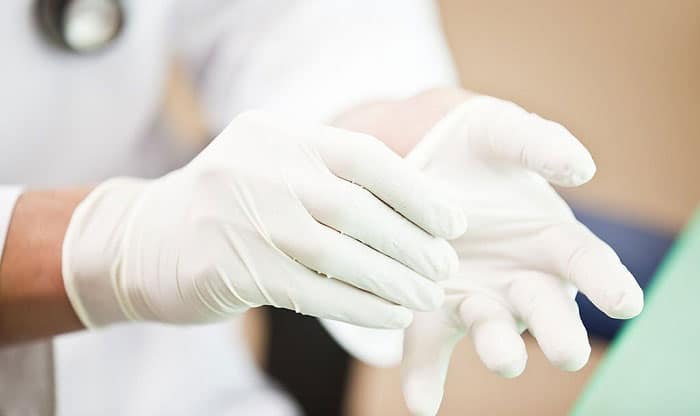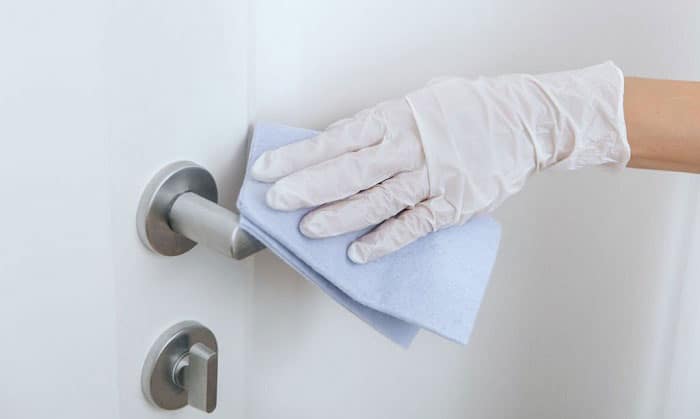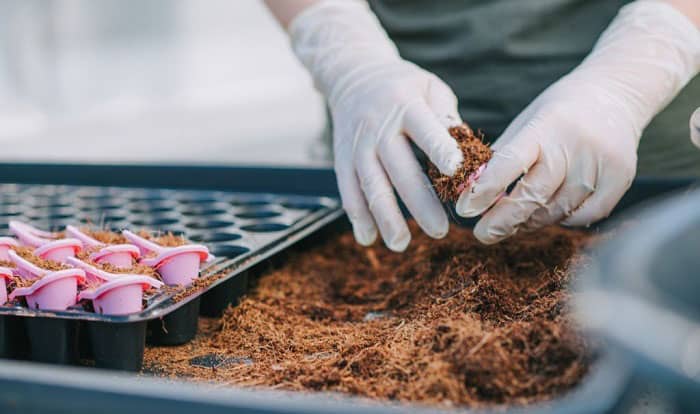Why do latex gloves turn yellow after a short time of use? My gloves turn yellow, can I wear them again?
Such yellow and brown tints are the results of exposure to sweat, saliva, sunlight, metals (such as copper from a coin), or improper storage. You might also notice that powder-free latex gloves turn yellow more often. It is because they went through a chlorination process to remove the powder from natural rubber.
Fortunately, you don’t have to dispose of rubber gloves whenever they show signs of color changing. Many times, the stains do not affect their protective barriers. In this article, we’ll explain why latex turns yellow, when you need to change gloves, and how to prevent such discolorations.
Table of Contents
Why Do My Latex Gloves Turn Yellow?
1. Exposure to sweat, saliva, sunlight, or metals
When you wear gloves for an extended period, your hands tend to feel hot and sweaty. The acid in human perspiration causes latex to turn yellow or brown. Exposure to metals also generates the same effect.
You might have touched metal materials (e.g., coins, the chains of your purse, your jacket’s zipper) before putting on the gloves. Sometimes, your working environment contains copper, iron, or aluminum. The good news is these stains do not affect the safety functions of the gloves. You can keep wearing them.
When you wear or place latex gloves outdoors for too long, they might change their color, too. But latex gloves turning yellow due to heat are damaged and unusable. Constant high heat hardens and cracks the gloves, which might lead to serious accidents when you wear them to handle harmful substances.
If you work under the hot sun or in a heated environment (0ver 30°C), we recommend against wearing disposable latex gloves.
2. Chlorinated treatment
Manufacturers use chlorine to break down and remove the powder, chemical residue, and latex protein. All powder-free latex gloves must undergo this procedure. It eliminates the natural powder, which, in turn, decreases the risk of latex allergies.
Chlorine-dipped rubber tends to turn yellow more quickly than others. So, don’t panic when your powder-free gloves discolor shortly after you put them on. Unless they show signs of deterioration, you don’t have to discard them.
3. Improper storage
Surgical and examination gloves have a shelf life of five years. But this heavily depends on the storage environment. Disposable gloves can degrade after one to two years if you store them improperly.
The longer you store latex gloves, the higher the chance they turn yellow. The discoloration is a warning sign. Do not wear gloves that have passed their shelf life. If the gloves haven’t reached their expiration date but exhibit discolorations, perform the following test to see if they fit for use:
- Stretch the gloves – Gently stretch the fingers and balms to see if they return to their intended shape.
- Do an air test – Fill the gloves with air and check for leakages. You can do this manually or by an inflator. Then, turn the glove inside out and repeat the step.
Usable gloves should show no signs of cracks, splits, or tears. They are elastic, flexible, and quickly return to the original form after being pulled.
How to Prevent Latex Gloves From Turning Yellow
Even when the discolorations don’t affect the gloves’ integrity, they might appear unhygienic and unprofessional. Follow these steps to prevent them.
Step 1: Wash and dry your hands carefully
Always wash your hands with soap, dry them thoroughly, and avoid touching any surface before donning gloves. You can use a water-based hand lotion before wearing gloves, but not petroleum or oil-based ones. If you have sweaty hands, it’s best to avoid hand lotion before wearing gloves.
Step 2: Wash the gloves after each use
If the yellow stains happen to your reusable rubber gloves, wash and dry them after each use. While the gloves are on your hands, add soap and water, and gently rub your hands together. Then, rinse thoroughly under running water. You can wipe them with a towel. Finally, take off the gloves and hang them to air dry.
If you want to wash the inside, wait until the outside is dry before turning them inside out and repeating the steps. You can watch this video for visualization:
Step 3: Use latex powdered gloves
Disposable gloves are thin and flexible, making them vulnerable to tearing and ripping. So, manufacturers add powder to reduce the risk of glove damage, assist in absorbing sweat, and allow easy donning.
The powder comes with drawbacks, though. It increases the development of latex allergy because wearers might inhale the particles in the air. It can also contaminate sterilized materials and surfaces.
But that shouldn’t scare you away from latex powdered gloves. If you are not allergic to latex or in a sterile working environment, powdered gloves offer many benefits. They are easy to don and remove, absorb moisture well, and rarely change colors. Powdered gloves are ideal for these fields:
- Cleaning
- Food preparation and processing (only cornstarch powdered gloves are allowed)
- Printing
- Painting and decorating
- General assembly
Step 4: Store latex gloves correctly
Lastly, always store disposable gloves in their original packaging in a cool, dry, and well-ventilated area. The room temperature should be under 100°F (37°C). Keep them away from dust, moisture, sunlight, X-ray, and heat. You should rotate stock following the first-in-first-out inventory control and use them before the expiration date.
Do Nitrile Gloves Turn Yellow?
Nitrile gloves, although more sturdy, durable, and chemical-resistant than their latex counterparts, can degrade and turn yellow. Sometimes, they even leave yellow stains on your skin after use.
Why do nitrile gloves turn yellow? Similar to latex ones, nitrile gloves change color due to the acid in sweat, saliva, and metal materials. Such discolorations are normal. You can continue wearing the gloves unless their integrity is compromised.
Conclusion
To wrap up, latex gloves turn yellow because of:
- Exposure to sweat, saliva, metals, and sunlight
- Chlorination process
- Improper storage
Most of the time, the yellow and brown tints do not affect the gloves’ integrity. You should only discard the gloves if they tear or split. Changing gloves unnecessarily will result in a waste of resources and put more trash in the landfill.
Now that you know why do latex gloves turn yellow and how to check gloves for degradation, we’re confident you will use latex gloves to their best potential.

Veronica is our content editor. She is a talent in delivery. Her main work is editing and writing articles that are both informative and simple to follow. She is in charge of synthesizing our understanding of what personal protection equipment (PPE) is needed in each job, how to best apply it, and how to visualize that equipment.




